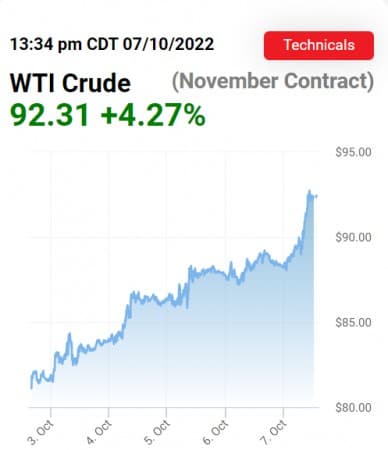Breaking News:

China's Rare Earths Strategy, Explained
China's recent discovery of new…

Rystad: OPEC's Oil Reserves are Much Lower Than Officially Reported
Rystad Energy’s latest research shows…
Crude Oil Prices Set To Finish Week With Major Gain
Crude oil prices are set to finish the week on a high note, with WTI rising more than $10 per barrel this week as OPEC+ agreed to slash its production targets for November by 2 million barrels per day.
The November contract WTI prices rose to $92.35 (+4.43%) on Friday afternoon, despite the better-than-expected Friday jobs report that will most certainly translate into even higher inflation, and as such, further Fed rate hiking.

The recent rate hikes have helped to keep oil prices in check at a time when U.S. crude inventories are below the five-year average despite a million barrels of SPR being released daily from the nation’s Strategic Petroleum Reserves.
The Labor Department’s job monthly jobs report showed that the United States added 263,000 jobs, with the unemployment rate falling to 3.5%--lower than the anticipated 3.7%.
The DJIA fell 2.17% today.
While OPEC+ moved to slash production by 2 million bpd starting next month, the realized production losses will likely be closer to 1 million bpd because many OPEC+ members are currently producing below the new targets anyway. But even a 1 million bpd increase at a time when SPR releases are soon expected to end is substantial and has the power to raise prices.
Brent crude prices were trading up on Friday by $3.72 per barrel, to $98.14.
Gasoline prices in the U.S. also rose on Friday, averaging $3.891 per gallon across the nation, up 9.4 cents on the week and 12.7 cents month over month. A year ago today, gasoline prices in the United States were $3.244 per gallon. The hike in the price of WTI, EIA reports of increased gasoline demand last week, falling gasoline inventories, and refinery outages across the United States are all behind the rising gasoline prices.
By Julianne Geiger for Oilprice.com
More Top Reads From Oilprice.com:
- France Considers Boosting Uranium Enrichment Capacity To Cut Reliance On Russia
- OPEC+ JMCC Committee Recommends 2 Million Bpd Production Cut
- Saudi Arabia, Russia To Cut 1.05 Million Bpd In November
Julianne Geiger
Julianne Geiger is a veteran editor, writer and researcher for Oilprice.com, and a member of the Creative Professionals Networking Group.
Open57.81
Trading Vol.6.96M
Previous Vol.241.7B
















